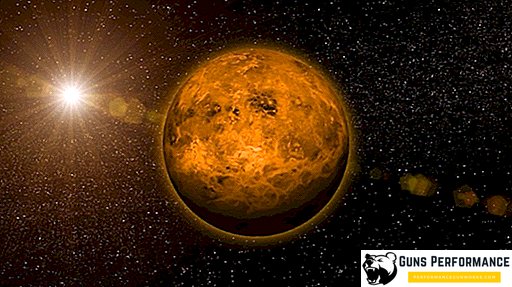Among the eight planets of the solar system, Venus is almost the only cosmic object, much like our planet. As a result of space and astronomical research of the planet, it turned out that its dimensions are almost the same as that of the Earth. Both planets are similar in mass and density. At first glance it seems that Venus is the most suitable planet for life, ready to hospitably meet earthlings in the process of subsequent development and colonization. In addition, it is the brightest object in the earth's horizon, for which he received the nickname "morning star". Man naively believed that a beautiful appearance corresponds to the same rainbow and attractive reality. Maybe it was many billions of years ago.

Today, the "morning star" is blacklisted and recognized as one of the most hostile to humanity extraterrestrial worlds. Scientists, after studying information about the planet, obtained as a result of the flights of the American and Soviet automatic stations Mariner and Venus, put an end to hypotheses and theories in which Venus was given the place of an extraterrestrial space paradise.
Discovery of the second planet of the solar system
The frequent appearance of Venus in the sky and its brightness have become one of the reasons for the increased interest in this space object. Even in ancient times, astronomers and astronomers paid attention to the bright star burning with white light in the morning dawn. It has always been extremely interesting for an earthly observer to learn more about this curious space object. Subsequently, it turned out that there is simply no other planet in the solar system capable of shining so brightly like Venus. In addition, it quickly became clear that this is the closest planet to Earth, literally our neighbor in a vast and endless space.

Ancient astronomers, under the influence of the beautiful radiance of the planet, gave our neighbor a sonorous and beautiful name - Venus, in honor of the ancient Greek goddess of love. Due to its successful and beautiful appearance, the planet is firmly entrenched in the culture of humanity, becoming a favorite object in literature.
The first information about the planet dates back to 1500-1600 BC. A description of a bright object in the sky, the current scientists found in the ancient Babylonian texts. The ancient Egyptians, Greeks and Maya Indians were well acquainted with the "morning star". The discovery of Venus as a planet took place only in the 17th century. At first, Galileo Galilei discovered that Venus moves around the Sun and has phases similar to the moon. Galileo compiled the first scientific description of the observed object and its movement through the sky. In 1639, the English astronomer Jeremy Horrocks with his telescope was able to detect the planet during its passage through the solar disk. The Russian scientist Mikhail Lomonosov, during his observations, managed to open the atmosphere of this celestial body, which gave reason to believe that Venus is a planet that has every chance of being inhabited.

Obtained as a result of astronomical observations, the data were very valuable and led scientists to believe that this planet and our Earth have much in common. It was hoped that the physical conditions on Venus are very similar to the parameters of the Earth’s habitat. For a long time in the scientific community and among science fiction writers there was an opinion that the second planet of the Solar System is the cradle of an extraterrestrial civilization. Only in the second half of the twentieth century, man obtained accurate astrophysical data about Venus, which dispelled the myth of the planet’s fitness for all forms of life.
Astrophysical characteristics of Venus
Venus is the third brightest object in our starry sky, second only to the Sun and the Moon. The planet is located on a heliocentric, almost regular circular orbit at 108.2 million km. from our star. The planets of the Solar System nearest to Venus are Mercury and Earth. The distance from Venus to Earth varies over a wide range from 38 to 261 million kilometers.
The rotation of the planet around its own axis occurs in 243 Earth days. However, due to the fact that Venus turns in the direction opposite to the Earth, from the East to the West, the magnitude of the Venusian day decreases exactly twice. Venusian days are 116.8 Earth days.

Moving in orbit around the Sun at a speed of 35 km / s, the planet makes a complete revolution in 224 Earth days. It is a characteristic phenomenon that Venus has an orbit and rotation around the Sun in a strange discrepancy. Due to its extremely slow rotation around its own axis in combination with the period of rotation of the planet around the Sun, Venus is facing the Earth in most cases almost the same side. This happens mainly when it is closest to Earth.
If you fly to Venus aboard a spacecraft, the journey will take 305 months. The first flight of the Mariner-2 space probe took just 153 days. The minimum distance to Earth is 90-100 days.

The composition of the planet Venus: structure and structure
Venus belongs to the group of rocky planets whose surface has a hard and stony base. Unlike the gas giants Jupiter, Saturn, Uranus and Neptune, the second planet has a high density. The average density of the planet is 5.204 g / cm3. On the basic physical parameters, Venus is very similar to Earth. This is indicated by the density of the planet, its mass and size.

The main parameters of Venus are as follows:
- the average radius of the planet Venus is 6052 km;
- the diameter of the planet in the equatorial plane is 12,100 + - 10 km, 95% of the earth's diameter;
- the length of the equator of Venus is 38025 km and is also 97% of the length of the Earth's equator;
- the surface of the "morning star" is 460 million square kilometers, 90% of the earth's surface;
- the astronomical mass of the planet Venus is 4.87 trillion trillion kg;
- the volume of the planet is 928 billion km3.
As can be seen from the list, Venus, by its basic physical parameters, is the twin planet of our Earth. However, this is only a form. In terms of its content, Venus is far from what we are used to representing it. The surface of the planet is hidden from the outside world by dense clouds, which are full of Venusian atmosphere.
The composition and structure of the planet are almost the same with the Earth. She also has a metal core surrounded by a mantle. The surface of the planet as well as on Earth is represented by a thin crust. It is believed that the Venusian core with a diameter of about 6000 km has an iron-nickel composition. The thickness of the mantle is quite impressive, about 3000 km. To establish the exact chemical composition of the Venusian mantle is not possible. Probably, as on Earth, it is based on silicates. The crust on the planet is identical in thickness to the terrestrial parameters and has an average thickness of 16-30 km.

At this similarity of the two planets end. Further, there are significant differences that make both planets perfect opposites. Tectonic processes on Venus took place in the distant past. The formation of the Venusian bark was completed approximately 500-600 million years ago. The surface of the planet is represented by frozen basalt seas separated by vast hills. Some elevations on the surface are higher than on the ground, and the height of the mountains of Venus reaches 11 km. The depressions and depressions, which are similar in shape and structure to the terrestrial oceans, occupy 1/6 of the surface of the planet. There are not many astrophysical craters on the planet. The largest of them has a diameter of 30 km, made by a fallen asteroid more than 1 million years ago.
The state of the inner core of the planet is unknown. However, the almost complete absence of a magnetic field, speaks in favor of the fact that the core is in a frozen state. The absence of convection between the liquid inner layers of the planet leads to the absence of a dynamo effect, which occurs as a result of friction between the inner layers of the planet. This explains that Venus, one of the two terrestrial twin planets, got such a weak magnetic field, only 5-10% of the strength of the earth's magnetosphere. The magnetic field of Venus is very weak and is mainly formed due to particles of the solar wind captured by the attraction of the planet.

Accordingly, on Venus, the magnitude of the acceleration of gravity is less - 8.87 m / s2 against 9.807 m / s² on Earth. In other words, a person on the surface of Venus will weigh 10% lighter than on our home planet. A more detailed study of the internal structure of the planet is not possible today. The data obtained so far are the result of mathematical calculations and radar scanning of the planet’s surface.
The most interesting object on Venus is the atmosphere of the planet.
The first data obtained from a photo from space about the surface of Venus did not become a breakthrough in the way of studying the planet. The surface of Venus is hidden from the eyes by dense layers of the atmosphere. That it is the decisive factor that forms the relief of the planet in the absence of active volcanic activity on the planet. Here there are two forms of surface erosion - wind and chemical. The material emitted as a result of volcanic eruptions, enters the atmosphere of the planet and already there, transforming during chemical reactions, falls to the surface in the form of Venusian sediments.
The chemical composition of the planet is quite simple:
- carbon dioxide 96.5%;
- the amount of nitrogen does not exceed 3.5%.
Other gases in the atmosphere of the planet are presented in a microscopic quantity. However, despite the almost complete absence of oxygen and hydrogen in atmospheric layers, the planet has an ozone layer, which is located at an altitude of 100 km.

Venusian atmosphere is the densest among the terrestrial planets. Its density is 67 kg / m3. In other words, the lower layers of the atmosphere are a semi-liquid medium dominated by carbon dioxide. As a result of such high saturation of the troposphere, the atmospheric pressure at the surface of Venus is enormous, amounting to 93 bar. This approximately corresponds to the Earth pressure, which will be 900 meters at the depth of the world ocean. A high concentration of carbon dioxide in the atmosphere of the planet has caused the greenhouse effect. As a result, a high temperature is noted on the surface of the planet, which can reach 475 degrees Celsius. This is more than on Mercury, which is much closer to the Sun.
Talking about the presence of water on Venus under such atmospheric conditions is not necessary. Dense clouds, composed of sulfuric acid and acid rain pouring onto the surface of the planet, and the Venusian seas represent lakes of sulfuric acid.
The winds on the surface of Venus are raging hard. The entire atmosphere of the planet is one huge raging hurricane, rushing around the surface of the planet at a speed of 140 m / s. Accordingly, it is not difficult to imagine how much wind blows on the planet.

The atmosphere of Venus is the main difference from our planet. The existence of any form of life in such conditions where the temperature reaches the melting point of lead is impossible. In addition, a high concentration of CO2 leads to the fact that instead of water on the planet, the main liquid is sulfuric acid.
Future plans for the study of venus
Venus - the closest space neighbor to us, a bright and beautiful star in our sky, in fact, is a real universal hell. The space studies that man undertook in relation to Venus in the second half of the 20th century made it clear that Venus is a hostile environment for us. For 40 years, 30 spacecraft were launched to the "morning star".
Most of the research was carried out in the framework of the Soviet program for studying the planet "Venus" and the American space program "Mariner". The European spacecraft Venera Express and the Japanese Akatsuki spacecraft launched to Venus in 2005 and 2010, respectively, ended the spacecraft research cycle for the "morning star".












